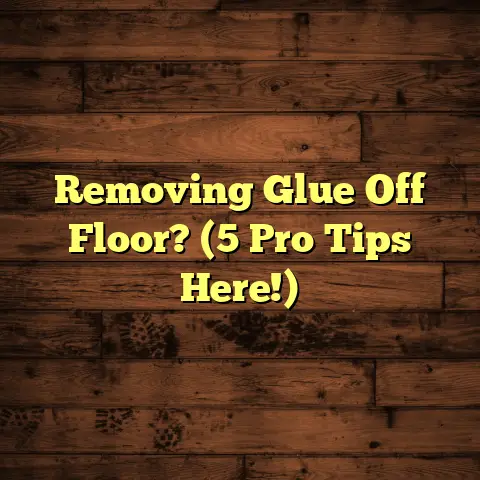Refinish Engineered Floors? (9 Things To Never Do!)
Imagine you’re about to cook a gourmet meal. You’ve got this amazing recipe, right? But what if you accidentally grab salt instead of sugar? Or forget to preheat the oven? Disaster, right?
Refinishing engineered floors is kinda the same! One wrong move, and you could end up with a flooring fiasco instead of a beautiful, revitalized space.
I’ve seen it all in my years as a flooring contractor, and trust me, some mistakes are way more common (and avoidable) than others.
That’s why I’m sharing the nine things you should never do when refinishing engineered floors. Let’s dive in!
Introduction: Engineered Floors 101
Engineered flooring has exploded in popularity, and I get it! It offers a great balance of aesthetics, durability, and price.
But what is it exactly?
Unlike solid hardwood, engineered flooring is made of layers. You’ve got a core (usually plywood or high-density fiberboard), and then a top layer, the veneer, of real hardwood.
This construction makes it more stable than solid wood, less prone to warping with humidity changes.
Homeowners often consider refinishing when their engineered floors start looking worn. Maybe they’re scratched, faded, or just outdated. Refinishing can breathe new life into them, but it’s not quite the same as refinishing solid hardwood.
That’s where knowing the potential pitfalls comes in! I’m going to walk you through the biggest mistakes I see people make, so you can avoid them.
Section 1: Understanding Engineered Floors
Let’s break down the anatomy a bit more. The core of engineered flooring is usually made of multiple layers of plywood, or sometimes MDF (medium-density fiberboard) or HDF (high-density fiberboard).
Then there’s the veneer. This is the magic layer, the one that gives you the look and feel of real hardwood. It can range in thickness from a very thin (less than 1mm) to a more substantial (3-4mm or even thicker) layer.
The thicker the veneer, the more times you can potentially refinish the floor.
Benefits of Engineered Floors:
- Durability: More resistant to moisture than solid wood.
- Stability: Less prone to warping.
- Versatility: Can be installed in more places, including basements.
- Cost-Effective: Generally less expensive than solid hardwood.
Why Refinish?
- Scratches and Dents: Everyday wear and tear takes its toll.
- Faded Finish: Sunlight can dull the original luster.
- Outdated Look: Maybe you want a different stain color.
- Increase Home Value: Freshly refinished floors look great to buyers.
Section 2: Mistake #1 – Ignoring Manufacturer Guidelines
This is huge! Think of the manufacturer’s guidelines as the recipe for your floor. They know their product best, right?
Ignoring them is like deciding to bake a cake at 450 degrees because you’re in a hurry. It’s probably not going to end well.
Every manufacturer has specific recommendations regarding refinishing, including:
- Sanding Restrictions: How much can you sand down?
- Approved Finishes: What types of finishes are compatible?
- Warranty Implications: Will refinishing void your warranty?
I’ve seen homeowners use aggressive sanding techniques on floors with thin veneers, completely sanding through to the core layer.
Boom! Ruined floor.
Or they’ll apply a finish that’s incompatible with the existing finish, resulting in peeling, bubbling, or a sticky mess that never fully cures.
Warranty Voided:
Most manufacturers will void your warranty if you refinish the floor improperly. This could leave you on the hook for replacement costs if something goes wrong.
Actionable Tip:
- Find the model number of your flooring (usually on the box or invoice).
- Visit the manufacturer’s website and download the installation and maintenance guidelines.
- Pay close attention to the section on refinishing.
Section 3: Mistake #2 – Using the Wrong Tools
You wouldn’t use a butter knife to chop vegetables, would you? Same principle applies here. Using the wrong tools can damage your floor and make the job much harder.
Here are some essential tools for refinishing, and why using the wrong ones is a bad idea:
- Sander:
- The Right Tool: A drum sander or an orbital sander
- For larger areas, an orbital sander for edges.
- The Wrong Tool: A belt sander (too aggressive for most engineered floors).
- The Right Tool: A drum sander or an orbital sander
- Edger:
- The Right Tool: An edger designed for flooring.
- The Wrong Tool: A handheld sander (difficult to control, can create unevenness).
- Vacuum:
- The Right Tool: A shop vacuum with a fine-dust filter.
- The Wrong Tool: A regular household vacuum (won’t capture fine dust, which can contaminate the finish).
- Applicators:
- The Right Tool: High-quality brushes, rollers, or applicators designed for your chosen finish.
- The Wrong Tool: Cheap brushes or rollers (can leave bristle marks or uneven texture).
Personal Story:
I once saw a homeowner try to use a belt sander on engineered flooring with a very thin veneer. He was trying to save time, but he ended up sanding right through the veneer in seconds.
The repair was costly and time-consuming. Using the right tools from the start would have saved him a lot of trouble.
Section 4: Mistake #3 – Skipping the Preparation Process
Prep work is everything! It’s like laying the foundation for a house. If the foundation is weak, the whole house is at risk.
The preparation process includes:
- Cleaning: Thoroughly vacuum and clean the floor to remove all dirt, dust, and debris.
- Repairing Damage: Fill any holes, cracks, or gouges with wood filler.
- Sanding (Lightly!): Use a fine-grit sandpaper to lightly sand the surface and remove the existing finish.
Why is Prep Important?
- Adhesion: A clean, smooth surface ensures that the new finish adheres properly.
- Appearance: Imperfections will be magnified by the new finish.
- Durability: A properly prepared surface will help the new finish last longer.
Consequences of Skipping Prep:
- Peeling Finish: The new finish may not adhere properly and could start to peel.
- Uneven Texture: Dirt and debris can create bumps and unevenness in the finished surface.
- Visible Imperfections: Scratches, dents, and other imperfections will be even more noticeable.
Pro Tip:
After sanding, use a tack cloth to remove any remaining dust particles. This will help ensure a smooth, clean surface for the new finish.
Section 5: Mistake #4 – Over-Sanding the Surface
This is where things get tricky. Remember that veneer layer we talked about? It’s precious! Over-sanding is the fastest way to ruin engineered flooring.
Why is Over-Sanding So Dangerous?
- Thin Veneer: Engineered floors often have a thin veneer layer (sometimes less than 1mm).
- Irreversible Damage: Once you sand through the veneer, you’re down to the core, and there’s no going back.
- Costly Repairs: Replacing damaged boards or the entire floor can be expensive.
How to Avoid Over-Sanding:
- Start with Fine-Grit Sandpaper: Use a fine-grit sandpaper (120-grit or higher) to start.
- Use Light Pressure: Don’t press down too hard on the sander. Let the sandpaper do the work.
- Sand Evenly: Keep the sander moving and avoid staying in one spot for too long.
- Check Your Progress: Regularly check your progress to ensure you’re not sanding through the veneer.
Signs of Over-Sanding:
- Color Change: The color of the floor changes significantly as you sand.
- Exposed Core: You can see the underlying plywood or fiberboard.
- Uneven Surface: The surface becomes uneven or bumpy.
Remember: The goal is to scuff the existing finish, not remove it entirely.
Section 6: Mistake #5 – Choosing the Wrong Finish
Not all finishes are created equal! Using the wrong finish can lead to a whole host of problems, from poor adhesion to discoloration.
Types of Finishes:
- Polyurethane: Durable, water-resistant, and available in oil-based and water-based formulas.
- Water-Based Polyurethane: Low odor, fast-drying, and environmentally friendly.
- Oil-Based Polyurethane: More durable and provides a richer, warmer tone.
- Moisture-Cure Urethane: Extremely durable but has a strong odor and requires professional application.
Compatibility is Key:
- Check Compatibility: Ensure that the new finish is compatible with the existing finish.
- Consider the Wood Species: Some finishes work better with certain wood species.
Consequences of Choosing the Wrong Finish:
- Poor Adhesion: The new finish may not adhere properly and could start to peel.
- Discoloration: The finish may change color over time.
- Soft Finish: The finish may be too soft and easily scratched.
- Incompatible with Existing Finish: Some finishes may not bond well with the existing finish, leading to bubbling or peeling.
Actionable Tip:
Consult with a flooring professional or the finish manufacturer to determine the best finish for your engineered floors.
Section 7: Mistake #6 – Refinishing in Poor Environmental Conditions
Temperature and humidity play a huge role in how well a finish cures. Refinishing in the wrong conditions can lead to a host of problems.
Ideal Conditions:
- Temperature: Between 65°F and 75°F (18°C and 24°C).
- Humidity: Between 40% and 60%.
Why are These Conditions Important?
- Curing Time: Temperature and humidity affect the drying and curing time of the finish.
- Adhesion: Extreme temperatures or humidity can affect the adhesion of the finish.
- Appearance: Improper conditions can lead to bubbles, cloudiness, or other imperfections in the finish.
Consequences of Refinishing in Poor Conditions:
- Slow Drying Time: The finish may take much longer to dry.
- Bubbles or Blisters: Bubbles or blisters may form in the finish.
- Cloudy Finish: The finish may appear cloudy or hazy.
- Poor Adhesion: The finish may not adhere properly and could start to peel.
How to Control Environmental Conditions:
- Use a Thermostat: Maintain a consistent temperature in the room.
- Use a Dehumidifier or Humidifier: Adjust the humidity level as needed.
- Ventilation: Ensure proper ventilation to remove fumes and promote drying.
Personal Experience:
I once refinished a floor in a basement with high humidity. The finish took forever to dry, and it ended up with a cloudy appearance. I had to redo the entire job! Now, I always check the temperature and humidity before starting any refinishing project.
Section 8: Mistake #7 – Neglecting to Test Samples
Imagine buying a new paint color without testing it on your wall first. You might end up with a color that looks completely different than you expected!
Testing samples is crucial for ensuring that you’re happy with the final result.
Why Test Samples?
- Color Accuracy: Colors can vary depending on the wood species and lighting conditions.
- Finish Compatibility: Ensure that the finish is compatible with the existing finish and the wood species.
- Appearance: See how the finish looks on your floor before committing to the entire project.
How to Test Samples:
- Choose an Inconspicuous Area: Select a small, hidden area of the floor to test.
- Apply the Finish: Apply the finish according to the manufacturer’s instructions.
- Allow to Dry: Allow the finish to dry completely.
- Evaluate: Evaluate the color, appearance, and compatibility of the finish.
What to Look For:
- Color: Does the color match your expectations?
- Appearance: Is the finish smooth and even?
- Adhesion: Does the finish adhere properly to the floor?
- Compatibility: Is the finish compatible with the existing finish and the wood species?
Remember: Testing samples can save you from making costly mistakes and ensure that you’re happy with the final result.
Section 9: Mistake #8 – Rushing the Process
Refinishing floors takes time and patience. Rushing through the process can lead to poor results and costly mistakes.
Why is Patience Important?
- Proper Preparation: Thorough preparation is essential for a successful refinishing project.
- Drying Time: Allow the finish to dry completely between coats.
- Curing Time: Allow the finish to fully cure before using the floor.
Consequences of Rushing:
- Poor Adhesion: The finish may not adhere properly if you don’t allow it to dry completely between coats.
- Bubbles or Blisters: Bubbles or blisters may form in the finish if you don’t allow it to cure properly.
- Soft Finish: The finish may be too soft and easily scratched if you don’t allow it to fully cure.
Tips for Avoiding Rushing:
- Plan Ahead: Set aside enough time to complete the project without rushing.
- Follow Instructions: Follow the manufacturer’s instructions for drying and curing times.
- Be Patient: Resist the urge to rush through the process.
Remember: Taking your time and being patient will help you achieve a high-quality finish that will last for years to come.
Section 10: Mistake #9 – Failing to Maintain After Refinishing
You’ve spent all this time and effort refinishing your floors. Don’t let it all go to waste by neglecting proper maintenance!
Why is Maintenance Important?
- Protect the Finish: Regular maintenance helps protect the finish from scratches, dents, and wear.
- Prolong the Lifespan: Proper maintenance can extend the lifespan of your refinished floors.
- Maintain Appearance: Regular cleaning helps maintain the appearance of your floors and keep them looking their best.
Common Maintenance Mistakes:
- Using Harsh Cleaners: Avoid using harsh cleaners that can damage the finish.
- Wet Mopping: Avoid wet mopping, which can damage the wood.
- Ignoring Spills: Clean up spills immediately to prevent staining.
- Failing to Use Protective Mats: Use protective mats under furniture and in high-traffic areas.
Proper Maintenance Tips:
- Use a Mild Cleaner: Use a mild cleaner specifically designed for hardwood floors.
- Dust Regularly: Dust or vacuum regularly to remove dirt and debris.
- Use a Damp Mop: Use a damp mop (not wet) to clean the floors.
- Protect from Scratches: Use felt pads under furniture legs to protect the floors from scratches.
Remember: Regular maintenance is essential for preserving the beauty and longevity of your refinished floors.
Conclusion:
Refinishing engineered floors can be a rewarding project, but it’s important to avoid these common mistakes.
Remember:
- Manufacturer Guidelines are Key: Always follow the manufacturer’s instructions.
- Use the Right Tools: Using the wrong tools can damage your floor.
- Prep is Everything: Thorough preparation is essential for a successful refinishing project.
- Don’t Over-Sand: Over-sanding can ruin engineered flooring.
- Choose the Right Finish: Not all finishes are created equal.
- Control Environmental Conditions: Temperature and humidity affect the drying and curing time of the finish.
- Test Samples: Testing samples can save you from making costly mistakes.
- Be Patient: Rushing through the process can lead to poor results.
- Maintain Your Floors: Regular maintenance is essential for preserving the beauty and longevity of your refinished floors.
By avoiding these nine mistakes, you can achieve stunning results and enjoy your beautifully refinished engineered floors for years to come! Take your time, do your research, and approach the project with the respect and attention it deserves. You got this!





